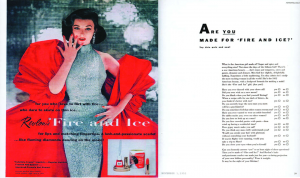HOW FIRE & ICE SHOWED THAT WOMEN ARE MORE THAN ‘ALL THINGS NICE’

I have written a story about Charles Revson before. It was entitled “The insightful bastard” which is explained by his self-proclamation that, “I built this business by being a bastard. I run it by being a bastard. I’ll always be a bastard, and don’t you ever try to change me” and his famous explanation of focusing on emotional benefits because “in the factory we make cosmetics; (but) in the drugstore we sell hope”.
Digging into his and the Revlon* brand’s history, there are numerous other stories but two in particular caught my eye, especially as I think they have relevance for future thinking brands in these difficult times .
The first reflects the insightfulness of Revson.
In 1933, as the Great Depression was ending, Revlon introduced colour-coordinated nail polish and lipstick.
While this might have seemed like an inopportune moment to launch a vanity business and his competitors at first called the colours ‘trashy’, Charles’ insight of the needs of women at the time was to convert into business success.
He instinctively understood that after a period where women had worn drab colors, recycling rather than buying new fashions, they wanted to feel feminine and ‘pretty’ again and so there would be a market for relatively inexpensive glamour. (“Relatively” because Revlon’s products were sold at a premium compared with traditional brands, many of which were only available in pale and transparent colours).
Their first products were nail varnishes, but the brand moved to what Charles called “Matching Lips & Tips”, introducing lipsticks to complement each of their nail-enamel shades. The idea is said to have come to him when he noticed a woman in a restaurant whose lips and nail polish didn’t match. He also realised that if women used the different shades to suit different outfits, moods, and occasions, it would expand the market…and it did.
The second story features not just Charles but Kay Daly who was a copywriter and vice-president at Norman, Craig & Kummel, the advertising agency. She would later join Revlon as Creative Director.
Together they created a concept that many believe revolutionised cosmetic advertising. They believed that there’s a little bit of bad in every good woman and. as Daly would say. every woman deserved “a little immoral support.”
That immoral support was a new shade – Fire and Ice – which they launched in the autumn of 1952.
The campaign to launch the shade featured a two-page spread, on one side it featured model Dorian Leigh in a silver-sequinned dress and wrapped in a red cape, and on the other it featured a questionnaire with a series of questions that tried to figure out if you were either naughty or nice; fire or ice.
Questions included “Do you blush when you find yourself flirting,” or “Would you streak your hair with platinum without consulting your husband,” and if you answered yes to eight out of the 15 questions, then you were ready for the lipstick.
The aim of course was to show there was a little bit of bad in every woman, even if she was a church-going suburban wife.
The ad was a sensation; nine thousand window displays were devoted to it, every newspaper and magazine wrote about it, and every radio announcer made reference to it.
Fire and Ice quickly became Revlon’s top shade
And the moral is people don’t always tell you want they want and need but that doesn’t mean they don’t really want it. How can you identify the things people want even when they don’t tell you?
Footnote: *There are two stories as to why the brand is Revlon and not Revson. The first is that he felt the ‘l’ softened it. The second was that there were three original partners in the business Charles, his brother, Joseph, and a chemist, Charles Lachman and, while they considered Revlac, it didn’t feel right. They decided to go with Revlon, the ‘l’ representing Lachman.